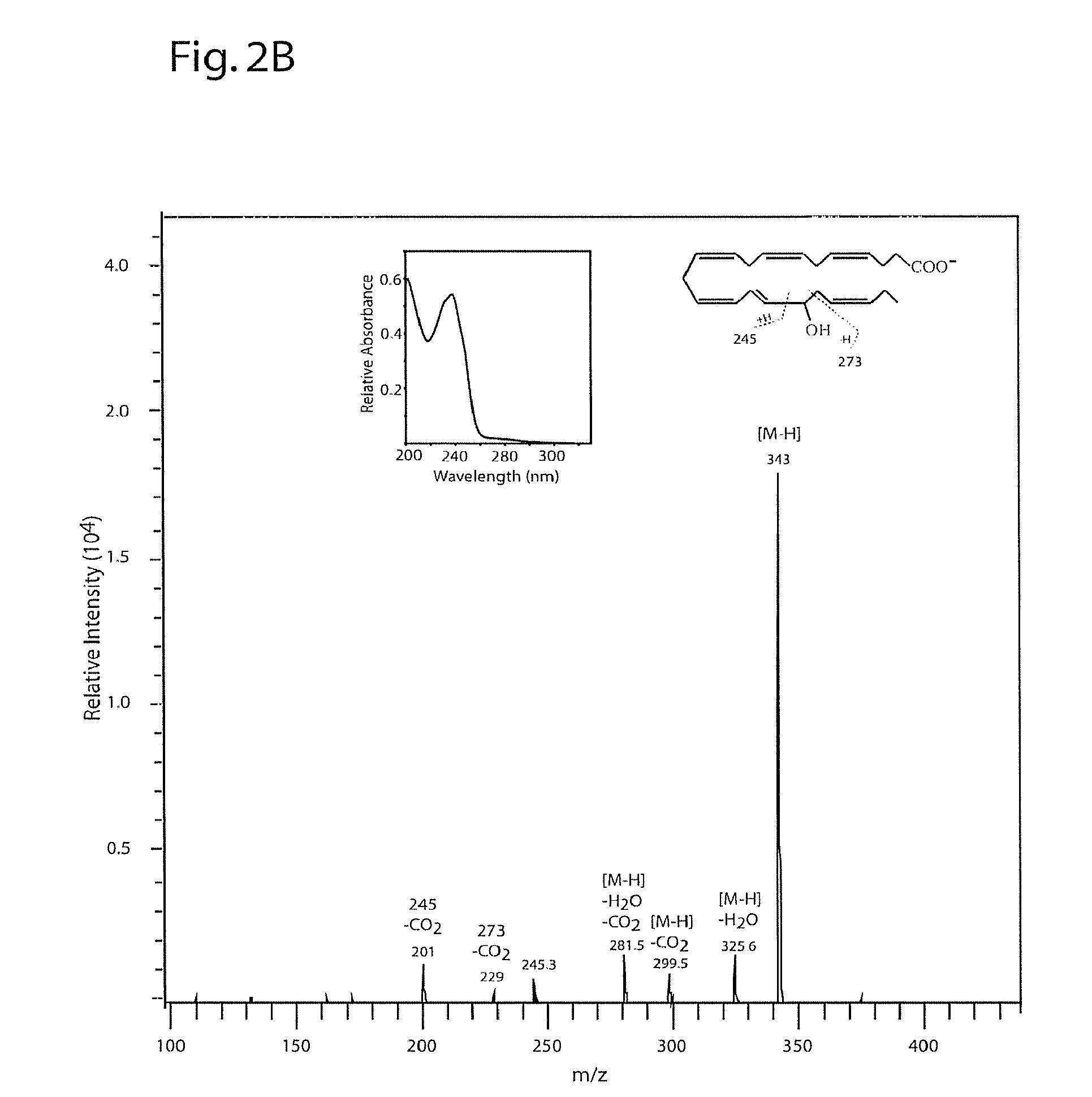Oxylipins from long chain polyunsaturated fatty acids and methods of making and using the same
a polyunsaturated fatty acid and long-chain technology, applied in the field ofdocosapentaenoic acid, can solve the problems of toxic addition of free fatty acids to the cultures, poor production of seaweed biomass in these cultures,
- Summary
- Abstract
- Description
- Claims
- Application Information
AI Technical Summary
Benefits of technology
Problems solved by technology
Method used
Image
Examples
example 1
[0212]The following example demonstrates that DPAn-6 can be completely converted to a mono-hydroxy diene derivative by 15-lipoxygenase, and is more efficiently converted than either of DPAn-3 or DHA.
[0213]Soybean 15-lipoxygenase (Sigma-Aldrich, St. Louis, Mo.) at a final concentration of 4 μg / ml was mixed into 100 μM solutions of DHA, DPAn-6, or DPAn-3 (NuChek Prep, Elysian, Minn.) in 0.05 M sodium borate buffer, pH 9.0, and the reaction mixtures were incubated at 0° C. Appearance of the mono-hydroxy conjugated diene derivatives of the fatty acids was monitored through absorbance at 238 nm. Conjugated diene products were quantified using an extinction coefficient of 28,000 M−1 cm−1 (Shimizu et al; Methods in Enzymology, 1990 Vol 187, 296-306). As shown in Example. 1, 100% of the DPAn-6 was efficiently converted to its conjugated diene derivative under these conditions, whereas about 85% of DPAn-3 and 50% of DHA were converted to their respective conjugated diene (mono-hydroxy) deriv...
example 3
[0217]The following example indicates the major 15-lipoxygenase products of DPAn-6 and demonstrates production of mono- and dihydroxy derivatives analogous to those produced from DHA (see Example 2).
[0218]DPAn-6 was treated with 15-lipoxygenase and analyzed by LC / MS / MS under the conditions described in Example 2. FIG. 3A depicts the structures of the mono- and dihydroxy reaction products of this DPAn-6 / 15-LOX reaction. FIG. 3B depicts MS / MS spectrum of the mono-hydroxy product showing molecular ion (m / z of 345) and fragments characteristic of 17-hydroxy DPAn-6. The inset shows the UV spectrum of this compound with the expected peak at 237 nm characteristic of a conjugated diene. FIGS. 3C and 3D depict MS / MS spectra of the two dihydroxy products with molecular ions (m / z of 361) and fragments characteristic of 10,17-hydroxy DPAn-6 (3C) and 7,17-dihydroxy DPAn-6 (3D) indicated. The UV spectrum insets show the expected triplet peaks at 270 nm characteristic of a conjugated triene for 10...
example 4
[0219]The following example indicates the major 15-lipoxygenase products of DPAn-3 and demonstrates production of mono- and dihydroxy derivatives analogous to those produced from DHA (Example 2) and DPAn-6 (Example 3).
[0220]DPAn-3 was treated with 15-lipoxygenase and analyzed by LC / MS / MS under conditions described in Example 2. FIG. 4A depicts the structures of the mono- and dihydroxy reaction products of this DPAn-3 / 15-LOX reaction. FIG. 4B depicts LC / MS spectrum of the monohydroxy product showing molecular ion (m / z of 345) and fragments characteristic of 17-hydroxy DPAn-3. Inset shows UV spectrum of this compound with the expected peak at 237 nm, characteristic of a conjugated diene. FIGS. 4C and 4D depict MS / MS spectra of the two dihydroxy products with molecular ions (m / z of 361) with fragments characteristic of 10,17-hydroxy DPAn-3 (4C) and 7,17-dihydroxy DPAn-3 (4D) indicated. The UV spectrum insets show the expected triplet peaks at 270 nm characteristic of a conjugated trien...
PUM
| Property | Measurement | Unit |
|---|---|---|
| Mass | aaaaa | aaaaa |
| Mass | aaaaa | aaaaa |
| Therapeutic | aaaaa | aaaaa |
Abstract
Description
Claims
Application Information
 Login to View More
Login to View More - R&D
- Intellectual Property
- Life Sciences
- Materials
- Tech Scout
- Unparalleled Data Quality
- Higher Quality Content
- 60% Fewer Hallucinations
Browse by: Latest US Patents, China's latest patents, Technical Efficacy Thesaurus, Application Domain, Technology Topic, Popular Technical Reports.
© 2025 PatSnap. All rights reserved.Legal|Privacy policy|Modern Slavery Act Transparency Statement|Sitemap|About US| Contact US: help@patsnap.com



